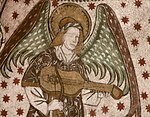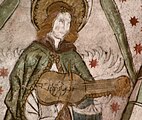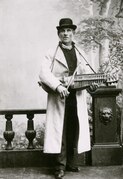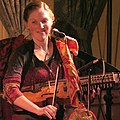Nyckelharpa
 Nyckelharpa being played | |
| String instrument | |
|---|---|
| Other names | key harp Danish: nøgleharpe ("key harp") Finnish: avainviulu ("key violin") German: Schlüsselfidel ("key vielle") Italian: viola a chiavi ("keyed viola") Polish: fiddle klawiszowe ("keyboard fiddle")[1] Spanish: viola de teclas ("keyed violin") |
| Classification | Bowed string instrument |
| Hornbostel–Sachs classification | 321.322–71 |
| Inventor(s) | Folk instrument |
| Developed | 12th century |
| Related instruments | |
| Hurdy-gurdy | |
Nyckelharpa network, an innovative dissemination of a music and instrument-building tradition with roots in Sweden | |
|---|---|
| Country | Sweden |
| Reference | 01976 |
| Region | Europe and North America |
| Inscription history | |
| Inscription | 2023 (18th session) |
| List | Good Safeguarding Practices |
Stemming from Sweden, the nyckelharpa (Swedish: [ˈnʏ̂kːɛlˌharːpa], plural nyckelharpor), meaning "keyed fiddle" or "key harp"(lit.), is a bowed chordophone, similar in appearance to a fiddle or violin but larger (in its earlier forms essentially a modified vielle), which employs key-actuated tangents along the neck to change the pitch during play, much like a hurdy-gurdy. The keys slide under the strings, with the tangents set perpendicularly to the keys, reaching above the strings. Upon key-actuation, the tangent is pressed to meet the corresponding string, much like a fret, shortening its vibrating length to that point, changing the pitch of the string.[2][3] It is primarily played underarm, suspended from the shoulder using a sling, with the bow in the overhanging arm.
The origin of the instrument is unknown, but its historical foothold and modern development is much larger in Sweden than other countries. Many of the early historical depictions of the instrument are found in Sweden, the earliest possibly depiction found on a relief located on a 14th century church portal. While historically not too common of an instrument in Sweden (relatively speaking), the violin outshining it in usage among spelmän (players of Swedish folk music), the nyckelharpa became a popular folk instrument in the Swedish province of Uppland during the 17th century, subsequently leading to its popularization and spread throughout Sweden the following centuries. By the 19th century it had become a "fine" instrument, being played at concerts in Stockholm,[4] and by the early 20th century it had become an archetypal instrument alongside the violin for Swedish folk music. Today it is considered by many to be the quintessential national instrument of Sweden.[5] The oldest surviving nyckelharpa is dated 1526 and is part of the Zorn Collections in Mora Municipality, Sweden.[4]
Besides Sweden, early depictions of nyckelharpor can also be found in Denmark, Germany and Italy, among other European countries. The earliest of these is found in a
History
1000s–1200s (first keyed instruments)

Development of keyed string instruments appears to have started during the
1300s–1500s (first keyed vielles)

The earliest possible depiction of nyckelharpor, or rather "keyed
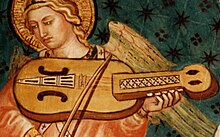
The earliest confirmed depiction of a nyckelharpa appears in an Italian church painting found in Siena, Italy, dating to 1408. It depicts an angel playing a vielle-looking nyckelharpa (a common nyckelharpa motif for the period), featuring five keyes and a keybox above the strings.
Throughout the 15th century, more depictions of nyckelharpor start appearing in church paintings, notably in Swedish and Danish churches, such as the Emmislöv Church, which has a painting of a nyckelharpa musician dating to 1450–1475.[10] Others include the Tolfta Church in Sweden, which has two paintings of angels playing nyckelharpa, dating to c. 1460–1525. Interestingly, most, if not all, Swedish nyckelharpa depictions on church paintings, lack keyboxes.[10] Early Danish nyckelharpa depictions, such as the ones found in the Rynkeby Church, dated to ca. 1560, all feature keyboxes.[10]
-
Angel with nyckelharpa, fresco in the church at Tolfa, Tierp Municipality, Uppland, Sweden. Unknown painter, 1503.
-
Angel with nyckelharpa, fresco in the church at Tolfa, Tierp Municipality, Uppland, Sweden. Unknown painter, 1503.
-
Angel with nyckelharpa, fresco in the Rynkeby church, Denmark. Unknown painter, ca. 1560.
The earliest known recorded name for nyckelharpor can be found in an early German music dictionary (German: Musiklexikon) by Martin Agricola, dating to 1529. There it is called a Schlüsselfidel ("key vielle").[10] The corresponding image features a keybox on the instrument.[10]
1600s–1800s (early modern period)

The german term, Schlüsselfidel, is mentioned in Theatrum Instrumentorum, a famous work written in 1620 by the German organist Michael Praetorius (1571–1621). At this time the nyckelharpa was not too common of an instrument in Sweden, the violin outshining it in Swedish folk music use.
Starting from the early 17th century, however, the nyckelharpa got a foothold as a popular folk instrument among spelmän (players of Swedish folk music) in the Swedish province of Uppland, which came to be the stronghold for nyckelharpa music the following centuries, including musicians like Byss-Calle (Carl Ersson Bössa, 1783–1847) from Älvkarleby.[9] From Uppland, the popularization of the instrument spread to the neighbouring provinces and eventually throughout Sweden. By the 19th century it had become a "fine" instrument which came to be played at concerts in Stockholm.[4]
-
The folk life painting Spelande bönder (playing farmers), by JJ Malmberg, 1863, depicting a farmer with a nyckelharpa
-
A folk life painting by JJ Malmberg from 1964, depicting a spelman with a nyckelharpa
-
Nyckelharpist Johan Edlund (1829–1903), with a kontrabasharpa
-
Spelman with nyckelharpa around the turn of the century, 1900
1900s–onward (modern period)

The popularization of the nyckelharpa continued and by the early 20th century it had become an archetypal instrument for Swedish folk music, equivelant to the violin. From this point the instrument would see a wide range of developments to make it a more modern instrument for a modern audience.

Changes by
The 1960s and 1970s saw a resurgence in the popularity of the nyckelharpa, with notable artists such as Marco Ambrosini (Italy and Germany), Sture Sahlström, Gille, Peter Puma Hedlund and Nils Nordström including the nyckelharpa in both early music and contemporary music offerings. Continued refinement of the instrument also contributed to the increase in popularity, with instrument builders like Jean-Claude Condi and Annette Osann bringing innovation to the bow and body.[11]
In 1990s, the nyckelharpa was recognised as one of the instruments available for study at the folk music department of the Royal College of Music in Stockholm (
The first World Nyckelharpa Day[12] took place on 26 April 2020 just as the world had gone into lockdown. All the events took place online, either as livestreams or pre-recorded videos on Youtube. This now is a yearly event taking place on the Sunday closest to 26 April – this being the birthday of the great nyckelharpa player Byss-Calle. The event is co-ordinated by British/Swedish nyckelharpa player Vicki Swan.[13][14]
English composer Natalie Holt used nyckelharpa for background score of the Disney+ series Loki from 2021.[15]
Reconstructional archaeology
In the 21st century there has been a growing interest among enthusiast to resurrect the early historical nyckelharpa designs. This has led to countless recreations of preserved historical copies, such as the
The nyckelharpa depicted in Siena, Italy, has been dubbed viola a chiavi di Siena (Italian for "Siena keyed viola"), or simply Siena-Harpa (also styled Sienaharpa) for short, relating to the Swedish naming-theme ("Siena harp"), and such a reconstruction was produced as part of an international research project around 2020, built by professional luthier Alexander Pilz, a seasoned maker of nyckelharpor working out of Leipzig, Germany.[6] The popularisation of the Italian design has led other luthiers in recent years to produce reproductions of the depiction as well.[1]
Technique
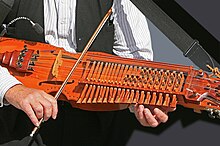
The nyckelharpa is usually played with a strap around the neck, stabilised by the right arm. Didier François, a violinist and nyckelharpist from Belgium, is noted for using an unusual playing posture, holding the nyckelharpa vertically in front of the chest. This allows a wider range of motion for both arms. It also affects the tone and sound of the instrument.
Some players may use a violin bracket to keep the nyckelharpa away from the body so that it can swing freely, causing it to sound more "open" as its resonance is not damped.[citation needed]
Variants
There are several variants of the nyckelharpa being produced and played today, differing in the number and arrangement of keys, number and arrangement of strings, and general body shape. They can be divided into types "with resonance strings" and types "without resonance strings".[17][18][19][20] There are also a variety of derivatives which belongs to the "keyed bowed chordophone-family" but do not necessarily have to be classified as nyckelharpor.[7]
Listed types below refer to Swedish/Nordic types as "variants", with other types being referred to as "derivatives".
Variants with resonance strings

The most common types of nyckelharpor are distinguished by having resonance strings. They can be divided into several subvariants, but the four main variants are as follows:[19][20]
- Kromatisk nyckelharpa ("chromatickey harp") – most predominant type of nyckelharpa. The three-row so-called "chromatic nyckelharpa", with the melody strings tuned A1 – C1 – G, a drone C (from the highest to the lowest string) that is only touched occasionally, and 12 resonance strings (one for each step of the chromatic scale).
- Kontrabasharpa ("double bass harp") – most popular during the 17th and 18th centuries. Typically the top has a high arch, and there are two oval-shaped soundholes in the lower bout called oxögon. The name "Kontrabasharpa" refers not to the pitch being any deeper than a standard nyckelharpa's (it isn't), but to the unstopped drone stringwhich always resonates below the melody strings during regular play. The two melody strings are set up on either side of the drone string, such that melodies can be played as double stops between a single melody string and the open drone string without the two melody strings ever clashing.
- Silverbasharpa ("silver base harp") – most popular in the 19th and early 20th centuries, so named because of the bass strings which are traditionally wound with silver. It is the immediate predecessor to the modern nyckelharpa, and the string configuration is identical, however it retains the older top with a more pronounced arch as well as the two oxögon. The main difference is that only the top two strings are stopped, meaning that the bottom C and G strings cannot play any other notes, and so nearly all of its repertoire is in the key of C. In addition, some silverbasharpor may be diatonic and not chromatic, and some keys may stop both melody strings at once.[21]
- Oktavharpa ("octave harp") – invented by Lennart and Johan Hedin in 1996. It is essentially a modern three-row nyckelharpa tuned an octave down, almost identical to a cello. It is the lowest-pitched variant of the nyckelharpa.
The resonance strings, or
Variants without resonance strings
Beyond the common variants with resonance strings, there are a variety of nyckelharpa designs without such. Some of examples include:
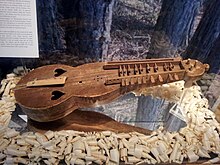
- Moraharpa ("Mora harp") – is the most common nyckelharpa derivative, based on a unique nyckelharpa found in the Swedish town of Mora Municipality, Sweden, dating to 1526 (although presumed to be from the later 17th century). This design has a straight bridge, one melody string, two drone strings, and one row of keys, with a body resembling a lute.
- Esseharpa (
- Vefsenharpa ("Vefsn harp") – Norwegian nyckelharpa derivative, based on nyckelharpa examples from the Norwegian municipality Vefsn (Swedish: Vefsen) in the county of Nordland. Similar to the Esseharpa but with inward curves on the body.[17]
Derivatives
- Viola a chiavi di Siena ("Siena keyed viola") or Siena-Harpa ("Siena harp") for short – is a nyckelharpa derivative based on the previously mentioned
- Viola d'amore a chiavi ("keyed viola da gamba, and therefore has the name "keyed viola d'amore".[7]
Gallery
-
Schlüsselfidel at the "Knochenhaueramtshaus", Hildesheim, Germany, 1529
-
Bronwyn Bird, member of Blue Moose, plays the nyckelharpa at a concert in 2007. Photo by Georgie Grd.
-
Burg Fürsteneck, Germany, playing a nyckelharpa built by Annette Osann
-
Didier François teaching his special technique at the International Days of the Nyckelharpa at Burg Fürsteneck, 2005
-
Mia Gundberg Ådin (Huldrelokkk) playing the Nyckelharpa at the music festival Bardentreffen in Nuremberg, 2015
Further reading
- Gunner Ahbäck; Gunner Fredelius. "Different typologies for the nyckelharpa, typologies and terminologies in short (Olika typologier för nyckelharpan, typologier och terminologi i korta drag)". nyckelharpansforum.net (in Swedish). Archived from the original on 2003-06-26. Retrieved 2023-06-26.
- Gunnar Ahlbäck; Gunnar Fredelius. "Nyckelharpans typologi" (in Swedish). nyckelharpansforum.net. Retrieved 2023-06-26.
- "Nyckelharpa History".
- "Nyckelharpa – olov johansson".
See also
References
- ^ a b c "fiddle klawiszowe". lucjankosciolek.wixsite.com (in Polish). Retrieved 2023-05-01.
Rekonstrukcja instrumentu z fresku znajdującego się w Palazzo Pubblico w Sienie we Włoszech, namalowanego przez Taddeo di Bartolo w 1408 roku. Instrument sopranowy o skali skrzypiec w pierwszej pozycji.
- ^ Ternhag, Gunnar; Boström, Mathias. "The Dissemination of the Nyckelharpa – The Ethnic and the non-Ethnic Ways". STM-Online vol. 2 (1999). Retrieved 25 December 2018.
- ^ "A Brief History of the Nyckelharpa". nyckelharpa.org. Retrieved 2023-05-01.
- ^ a b c "Nyckelharpan som nationalinstrument". riksdagen.se. Retrieved 2023-05-01.
- ^ "National Instruments of Sweden". folkways.si.edu. Retrieved 2022-09-13.
- ^ a b c "The "Siena-Harpa" Project". marcoambrosini.eu. Retrieved 2023-05-01.
- ^ a b c "Viola d'amore a chiavi". nyckelharpa.be. Retrieved 2023-05-01.
- ^ Brashers, Bart. "A Brief History of the Nyckelharpa". American Nyckelharpa Association. Retrieved 25 December 2018.
- ^ ISBN 978-1-85828-635-8.
- ^ a b c d e "history-of-the-nyckelharpa_per-ulf-allmo-de.pdf" (PDF). nyckelharpa.eu (in German). Retrieved 2023-06-26.
- ^ "Nyckleharpa History". www.nyckelharpa.org. Retrieved 2022-09-13.
- ^ "World Nyckelharpa Day – Sunday 23 April 2023".
- ^ "The Nyckelharpa Effect – Virtual and in Real life Nyckelharpa Learning".
- ^ "2020 – World Nyckelharpa Day". Retrieved 2022-09-15.
- ^ Burlingame, Jon (2021-07-01). "The Weird, Unsettling Music of Loki: Composer Natalie Holt Breaks Down the Marvel Series' Score". Variety. Retrieved 2022-09-15.
- ^ a b "Soittimet". kansanmusiikinmatkassa.blogspot.com (in Finnish). Retrieved 2023-06-26.
- ^ a b c Gunnar Ahlbäck; Gunnar Fredelius. "Different typologies for the nyckelharpa, typologies and terminologies in short (Olika typologier för nyckelharpan, typologier och terminologi i korta drag)". nyckelharpansforum.net (in Swedish). Archived from the original on 2003-06-26. Retrieved 2023-06-26.
- ^ Gunnar Ahlbäck; Gunnar Fredelius. "Nyckelharpans typologi" (in Swedish). nyckelharpansforum.net. Retrieved 2023-06-26.
- ^ a b "Nyckelharpa History".
- ^ a b "Nyckelharpa – olov johansson".
- ^ "The Nyckelharpa". nyckelharpansforum.net. Retrieved 2022-09-13.
External links
- "home". The American Nyckelharpa Association.
- "International Days of the Nyckelharpa at BURG FÜRSTENECK (Germany) – workshop, concert, conference, exhibition, seminar and exchange of experience".
- "Nyckelharpa in Europe – The European Nyckelharpa Cooperation". www.nyckelharpa.eu.
- Kornel Mariusz Radwanski plays The Alchemist's Dance on nyckelharpa with James Kline on archharp-guitar on YouTube
- "The Nyckelharpa Effect – Virtual and in Real life Nyckelharpa Learning".Nyckelharpa Workshops and Teaching in the UK
- What is a Nyckelharpa? on YouTube

